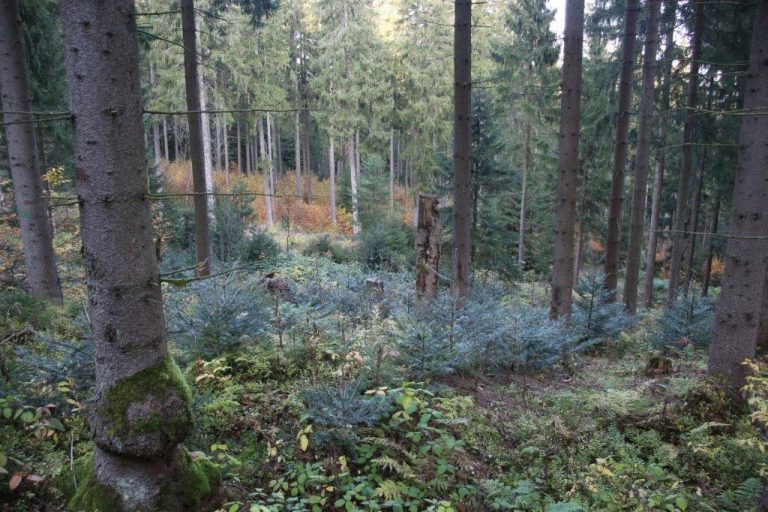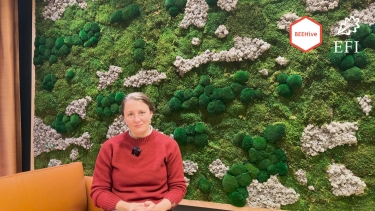“Nature conservation in managed forests does come at a price” - Interview with forester Andreas Pommer
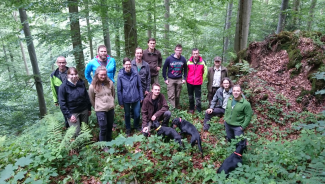
Andreas Pommer is the head of the Eibenstock forest district in the Saxony State Forest Service. The Eibenstock district is situated in the lower mountain range of the Erzgebirge with over 90 % of spruce in the upper canopy layer. The forest in that region has a painful history shaped by severe air pollution and the state-owned red deer hunting area of the 1970s-1980s. In “his” forest district, Andreas Pommer has made it his goal for about the last 15 years to combine forest management and nature conservation - with close-to-nature silviculture and forest conversion towards structurally rich, mixed forests. Deadwood also plays an important role as well as habitat trees, high stumps, and moor revitalization. Pommer also integrates stream valley renaturation, the creation of small water bodies, maintaining and enhancing forest edges and providing for nesting aids. Further, he uses innovative methods such as marteloscopes to raise awareness for nature conservation in managed forests. For these reasons the German magazine “Forstpraxis” (“Forest Practice”) has nominated him for the title of "forester of the year" in 2020. We had a personal conversation with Andreas Pommer about the challenges for forestry in times of climate change and the growing expectations towards forests - and the potential of “integrative” approaches, i.e. how we can integrate many different forest functions in management while ensuring healthy and resilient forests in the long term.
Mr. Pommer, there are a lot of expectations towards forests: They should provide us with wood, preserve or, if possible, increase biodiversity, and we as citizens want to enjoy the forest in our free time. Can forests do all that? And if so, how?
Our forest area in Germany has decreased from originally nearly 100% to only 30%, in Saxony even less (28%). However, the functions and services that forests should fulfil for society have increased significantly.
Forestry is being practiced for centuries. Already in the Middle Ages, huge parts of the originally forested are in Central Europe were cleared by humans. For a long time, the wood on the remaining forest areas was then the only source of energy and building material. Forest regeneration and nature conservation issues hardly played a role until the age of industrialization. Today multifunctional forest management is the main focus. All forest owners are legally obliged to give equal priority to the utilization, protection and recreational functions. In this regard, the public forest serves as role model. With the concept of integrative forest management, we try to consider the issues of nature conservation over the entire forest. It thus differs from a segregation approach, where the emphasis is given to a division of forest areas into set-asides for nature conservation purposes and production areas. Given the fact that Germany is not able to cover its own wood consumption, this seems difficult to me to convey. Setting aside forest areas would lead to importing wood from other parts of the world, often from virgin forests with questionable utilization concepts, high transport costs and waste of resources. For me, things are somehow upside down.
If we need more than we produce ourselves - what do you suggest?
First of all, wood consumption in Germany should be reduced. Above all, the energetic use of wood through alternative energy sources such as wind and solar power should be promoted. Given the current technology, this can be achieved without major problems, it is rather a political task. Currently, the forest is receiving increased attention for sequestering carbon. Wood, which we produce ourselves, should be of high quality and integrated into long-term utilization processes to keep the carbon stored in wood products. The accumulation of carbon in the soil is also expanded for increasing productivity and to act as carbon sink. Carbon can be stored in the soil very easily through the roots of deep-rooting trees and shrub species. Humus formation supports this process through biomass accumulation. From my point of view, the different forest functions can be combined very well, but it is not possible without trade-offs. The best solution for me is thus the integrative approach, in which we ensure multifunctionality on the entire forest area. Isolated solutions will be only of limited use when it comes to nature conservation and not halt species extinction.
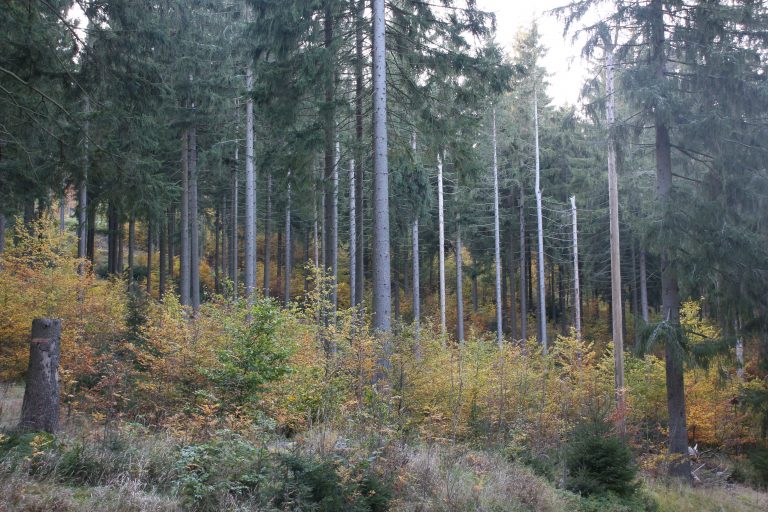
If we need more than we produce ourselves - what do you suggest?
Nature conservation will not work without society giving up on something - regardless of whether we are talking about species, biotope or process conservation. After the ice age in Central Europe, “forest communities” have established themselves on various locations, which have developed largely an equilibrium state in their plant composition, biomass build-up and biomass decomposition, as well as humus and soil formation. In these biocenoses (community of organisms of different species in a definable habitat), an almost unimaginable network of plant and animal species are active. Consequently, human overexploitation forests must therefore result in species loss. At the same time, human use has created cultural landscapes that can also be species-rich and should be preserved and promoted as part of cultural conservation. Integrative, nature-based forest management will also not be able to solve the decline of species and restore the “original state”. It can, however, support steps towards preserving biodiversity in our forests, as compensation.
What do you mean by “compensation”?
One of the cornerstones of integrative forest management in relation to nature conservation is the near-natural forest conversion towards mixed, structured and stable forests. On the other hand, for me the entire process of wood decomposition with its many dependent species beneficiaries is part of it. Such are for example, mushrooms, mosses, insects, spiders or birds as well as the occurrence of broken branches and tree cavities, methuselah and habitat trees. Standing and lying biotope and dead wood are also of particular importance. Refraining from removing it plays a major role and is easy for a forester to implement. Further, one can increase the diameter for wood remaining in the forest and create high stumps. You can stipulate that only sawn wood will be further processed in order to increase the contribution margin, i.e. the obtainable revenue, and not unnecessarily invest resources in the forest. Another way to protect biotopes and species is to maintain and create more open and light-flooded forest biotopes, for example, at forest edges and along forest roads. In my district that means reducing the amount of spruce and promoting shrubs and flowering plants. Flowering plants and light are crucial for a diverse abundance of insects and many of their beneficiaries. Also the promotion of near-natural creek gorges and streams including their plant communities play an important role, as do the preservation and restoration of special biotopes -especially rare dry, xerothermic (dry and warm), as well as wet, hydromorphic (water-influenced) biotopes (peatland revitalization).
As a manager, you have good opportunities to make an impact. Especially important to be successful in forest conservation and the creation of near-natural forest habitats is the regulation of ungulate populations, such as roe deer and red deer, as their predators, wolf, lynx and bear, are usually missing in our cultivated forests. Browsing unfortunately causes a considerable loss of species to the herb, shrub and tree species composition. As you can see, there are innumerable ways to implement nature conservation in the forest. We “just” have to do it!
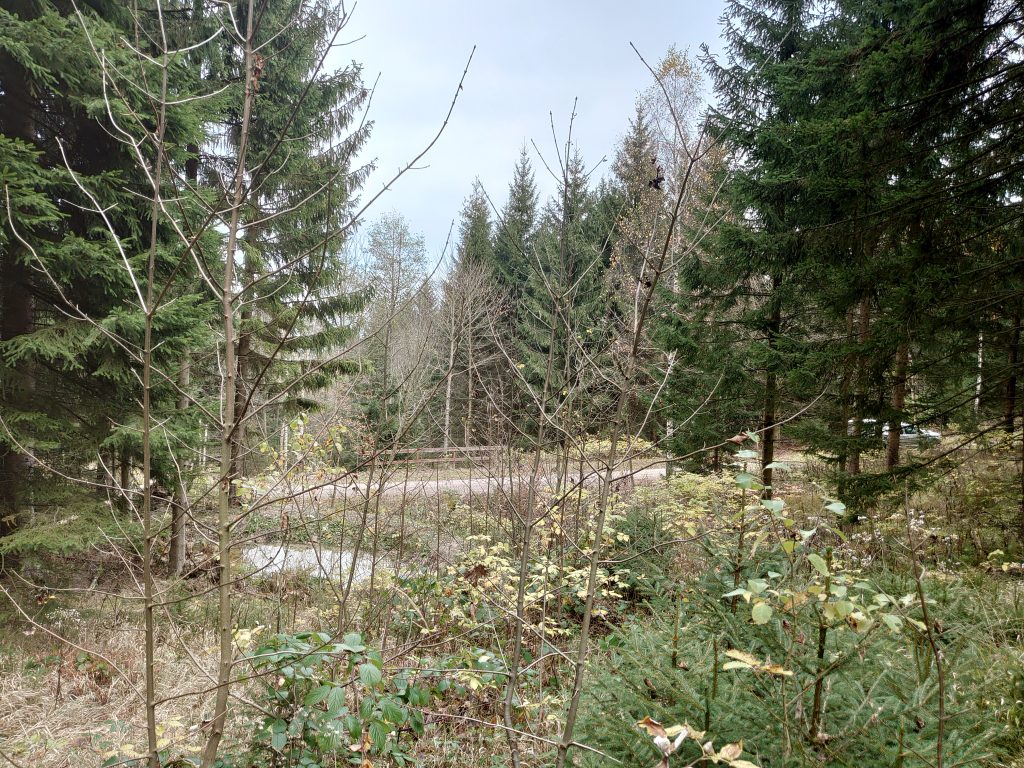
You have been working with marteloscopes for several years. What is special about your demonstration areas?
More than 10 years ago, at a conference of the ‘Arbeitsgemeinschaft Naturgemäße Waldwirtschaft - ANW’ (Pro Silva, Germany), I established numerous growth and yield plots in various development phases and forest locations in my Eibenstock forest district. I wanted to determine the actual growth processes, above all the growing stock and increment development which were usually only collected by means of an estimate in forest planning. I then have gradually developed marteloscopes from these plots The term “marteloscope” is derived from the French word for tree selection 'martelage' and the Greek term 'skopein' (look), meaning literally “having a closer look” at a tree selection. A marteloscope is usually a 1-hectare (10,000 m²) forest area in which each individual tree is precisely recorded including its location, diameter, height but also economic (in €) and ecological value (in points, e.g. for woodpecker cavities) and made available via an App running on handheld devices.
A particularly interesting area is an approximately 200-year-old mixed stand of spruce, beech, silver fir and sycamore maple with a plenter-like structure (i.e. young and old trees intermixed within a small area) and a high proportion of deadwood (approx. 100 m3/hectare) at about 800 m. I have been working for about 15 years in this stand towards creating an optimal balance between wood supply and the preservation of important microhabitats, such as woodpecker and mould cavities, branch breakages, moss and lichen growth or fruiting bodies of fungi. As a result of continuous and consequent regulation of game populations, it is possible to regenerate naturally all tree species of the upper canopy without fencing or individual protection. This stand, allows to nicely demonstrate how forest management can combine economic with and ecological aims and that such requires a consequent hunting regime.
How do you convey integrative forest management, e.g. to forest visitors - and what role do marteloscopes play here?
For years, I have established good examples in my district, which I present to visitors on many occasions (e.g. excursions). From my point of view, scientific support is important for managing forests. They allow to document the development of a forest and help to derive target conformity of implemented measures. Marteloscopes allow to explain and bring the connections between forest use and forest protection closer to forest visitors. To this end, species surveys should be carried out at regular intervals in such marteloscopes besides parameters already recorded. This way marteloscopes can act as reference plots. A good example from my district is the recording of more than 70 different moss species and 130 fungus species as well as an assessment of moths in the above mentioned marteloscope “Riedert”. The assessment to place in July 2020 and resulted in the identification of 70 different moth and beetle species. These successes are also announced to the visitors. In addition, the increasingly colourful and structurally rich forest in my district - especially the one with a nearly 90% share of mixed species regeneration - shows a positive effect on people compared to pure coniferous stands.
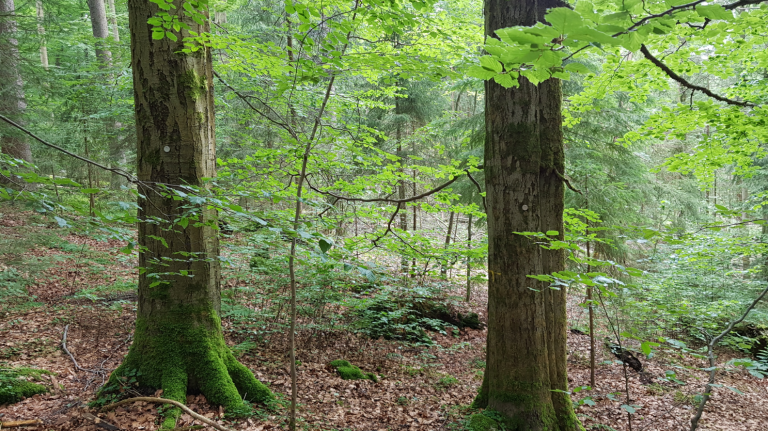
In your opinion, how should forest management look like in the future, so that we can benefit from the ecosystem services of the forest in the long term?
In my opinion, not only ensuring forest cover but increasing its area comes first if we want to benefit from ecosystem services as a society. The loss of forest functions and services for the common good, as we are currently experiencing due to climate change and associated damages (so-called “calamities”) in commercial forests and in many large, protected areas, poses a huge task to society. First of all, it is important to create framework conditions for near-natural forest conversion. From my experience, the priority should be the adaptation of ungulate populations. Without this, there will be no such forest conversion. Nature is very well able to react to changing climate conditions. Central Europe is climatically a woodland, and thus the “final stage of succession” almost everywhere would be forest. This means that if, for example, a field was no longer cultivated, a forest would be established and it would also remain forest.
If everything becomes forest in the end - do we even have a problem?
The question is what kind of forest are we talking about: if the important, naturally regenerating deciduous tree species are repeatedly browsed because roe deer and red deer populations are not effectively regulated either by humans and/or large predators, then in many places nature can only persist in successional stages that do not fulfil the desired multifunctionality of climax forests (which in ecology refers to a relatively stable “end state” of vegetation). Furthermore, financial support is needed for private and communal forests, which is specifically tailored to multifunctionality and the fulfilment of overall forest welfare.
What if you had a “forest wish” for future generations?
For me, a future forest is mixed, rich in structure, rich in deadwood and rich in species. Depending on the location, there is a near-natural tree species composition, continuous regeneration, ideally from natural regeneration, and there is no need for protecting against browsing and peeling (i.e.no fences or no individual tree protection measures). Furthermore, I would like to see skid trails with a minimum spacing of 40 m and a sufficient development system of forest roads species-rich forest edges, near-natural creeks or river courses. Difficult or unmanageable forest sites (e.g. bogs, steep slopes, floodplains) should remain refuges for endangered animal and plant species. In forest management or timber harvesting, the use of resources and technology and the impact on nature should always be balanced with the many different benefits for people. In the forest of the future, valuable wood will hopefully still be harvested as a renewable resource. On the other hand, wood of lower value, increasingly also larger dimensioned timber, will remain in the forest for supporting natural processes, providing habitats, acting as water reservoir, and improving nutrient and as humus availability. Finally, I wish that we can continue to freely enter a future forest and enjoy its beauty and uniqueness.
